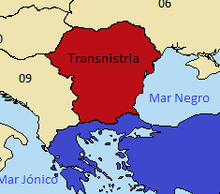Nation/Autonomous territory of Transnistria
| This page is a work in progress by its author(s) and should not be considered final. |
| The Autonomous Territory of Transnistria Transnistria
|
|||||
|---|---|---|---|---|---|
|
|||||
| Motto: "Мы славим тебя, Приднестровье" "We sing the praises of Transnistria" |
|||||
Transnistria in The Order of The Antilles
|
|||||
| Region | The Order of The Antilles | ||||
| Capital | Tiraspol | ||||
| Official languages |
|
||||
| Demonym | Transnistrian | ||||
| Government | Semi-Presidential Republic | ||||
| - | President | Yevgeny Shevchuk | |||
| - | Prime Minister | Tatiana Turanskaya | |||
| Legislature | Supreme Council | ||||
| Partially recognized state | |||||
| - | Independance Declared | 2 September 1990 | |||
| - | War of Transnistria | 2 March - 21 July 1992 | |||
| - | Recognition | 3 Non-WA Members | |||
| Area | |||||
| - | Total | 4,163 km2 km2 1,607 sq mi sq mi |
|||
| - | Water (%) | 2.35% | |||
| Currency | Transnitrian Ruble (PRB) |
||||
| Time zone | EET (UTC+2) | ||||
| Date format | mm.dd, yyyy (i.e. 1.02, 2006) |
||||
| Calling code | +373 | ||||
| Internet TLD | none | ||||
The Autonomus Territory of Transnistria (Russian: Автономная территория Приднестровья) is a breakaway state located mostly on a strip of land between the River Dniester and the eastern Moldovan border with Ukraine. Since its declaration of independence in 1990, and especially after the War of Transnistria in 1992, it is governed as the Pridnestrovian Moldavian Republic (PMR, also known as Pridnestrovie) a state with limited recognition that claims territory to the east of the River Dniester, and also to the city of Bender and its surrounding localities located on the west bank, in the historical region of Bessarabia. The terms "Transnistria" and "Pridnestrovie" both reference the Dniester River.
Unrecognised by any United Nations member state, Transnistria is designated by the Republic of Moldova as the Transnistria autonomous territorial unit with special legal status (Unitatea teritorială autonomă cu statut juridic special Transnistria), or Stînga Nistrului ("Left Bank of the Dniester").
Because of the Russian military contingent present in Transnistria, the European Court of Human Rights considers Transnistria "under the effective authority or at least decisive influence of Russia".
Transnistria, Nagorno-Karabakh, Abkhazia, and South Ossetia are post-Soviet "frozen conflict" zones. These four unrecognized states maintain friendly relations with each other and form the Community for Democracy and Rights of Nations.
History
Geography
Transnistria is landlocked and borders Bessarabia (i.e., the rest of Moldova, for 411 km) to the West, and Ukraine (for 405 km) to the East. It is a narrow valley stretching in the North-South direction along the bank of the Dniester river, which forms a natural boundary along most of the border with (the rest of) Moldova. Tiraspol, the capital and largest city of Transnistria, has about 160,000 inhabitants.
The territory controlled by the PMR is mostly, but not completely, coincident with the left (eastern) bank of Dniester. It includes ten cities and towns, and 69 communes, with a totality of 147 localities (counting the unincorporated ones as well). Six communes on the left bank (Cocieri, Molovata Nouă, Corjova, Dubăsari|Corjova, Pîrîta, Coșnița, and Doroțcaia) remained under the control of the Moldovan government after the War of Transnistria in 1992, as part of the Dubăsari District. They are situated north and south of the city of Dubăsari, which itself is under PMR control. The village of Roghi of Molovata Nouă Commune is also controlled by the PMR (Moldova controls the other nine of the ten villages of the six communes).
On the west bank, in Bessarabia, the city of Bender and four communes (containing a total of six villages) to its east, south-east, and south, on the opposite bank of the river Dniester from the city of Tiraspol (Proteagailovca, Gîsca, Chițcani, and Cremenciug) are controlled by the PMR.
The localities controlled by Moldova on the eastern bank, the village of Roghi, and the city of Dubăsari (situated on the eastern bank and controlled by the PMR) form a security zone along with the six villages and one city controlled by the PMR on the western bank, as well as two (Varnița, Anenii Varnița and Copanca) on the same west bank under Moldovan control. The security situation inside it is subject to the Joint Control Commission rulings.
The main transportation route in Transnistria is the road Tiraspol-Dubăsari-Rîbnița. North and south of Dubăsari it passes through the lands of the villages controlled by Moldova (Doroțcaia, Cocieri, Roghi, while Vasilievca is entirely situated east of the road). Conflict erupted on several occasions when the PMR prevented the villagers from reaching their farmland east of the road.
Transnistrians are able to travel (normally without difficulty) in and out of the territory under PMR control to neighbouring Moldovan-controlled territory, to Ukraine, and on to Russia, by road or (when service is not interrupted by political tensions) on two international trains, the year-round Moscow-Chișinău, and the seasonal Saratov-Varna. International air travellers rely on the airport in Chișinău, the Moldovan capital, or the airport in Odessa, in Ukraine.



